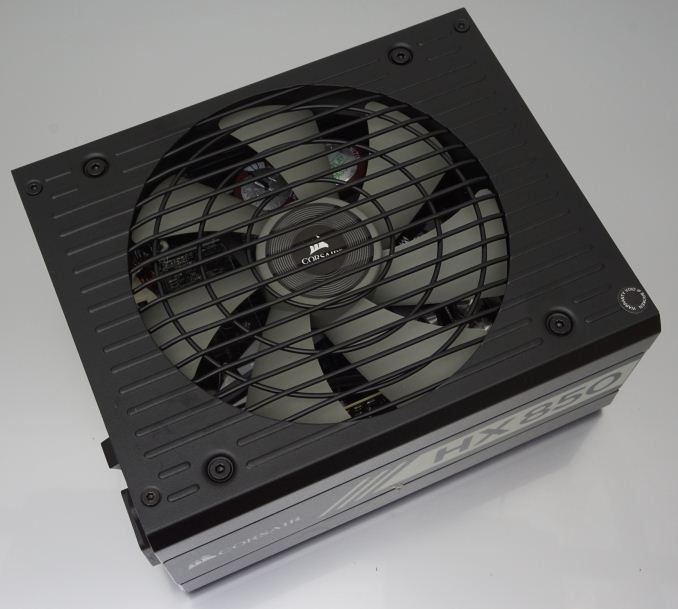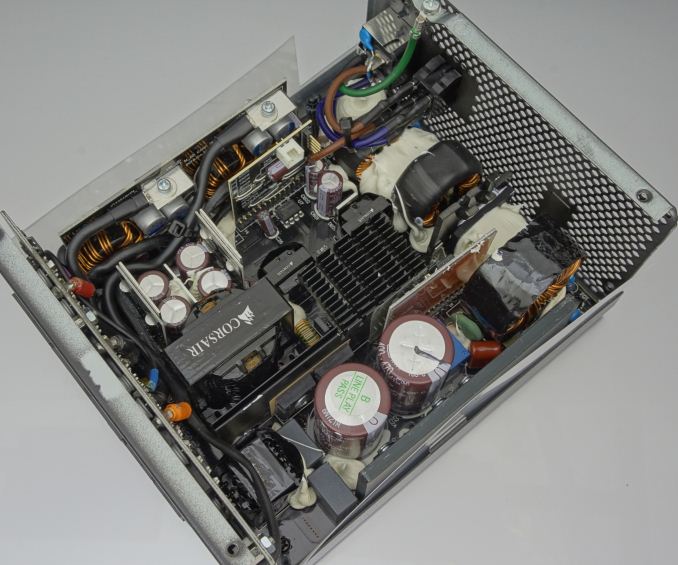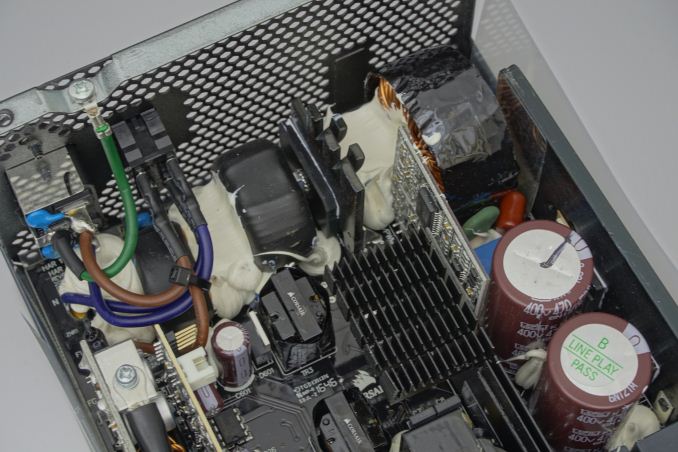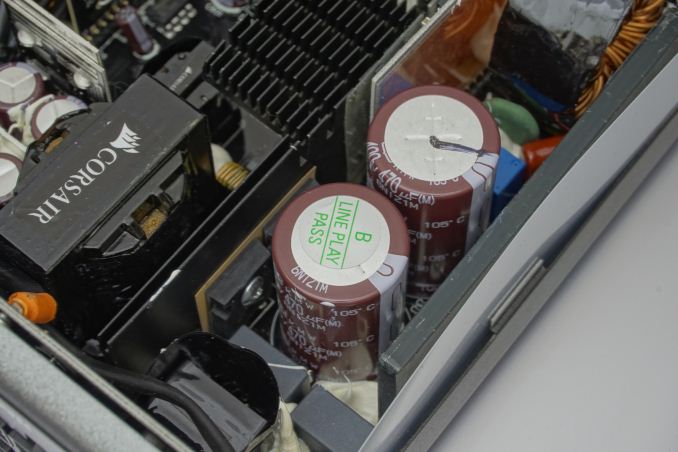The Corsair HX850 80Plus Platinum PSU Review
by E. Fylladitakis on October 24, 2017 8:00 AM EST
In this review we are having a look at the latest revision of Corsair’s HX PSU series. The main improvements of the new series revision are an improved certification to Platinum, a fully modular design, and now an extended 10-year warranty. We are testing the HX850 model, suitable for 850W which can easily feed a powerful dual GPU gaming/workstation system.
Recent Power Supply Reviews
AnandTech tests a good number of power supplies each year, mostly in the popular power ranges (650-850W) with a few reviews now-and-again for small form factor parts or larger behemoths. Here are the power supplies we have reviewed in the last twelve to eighteen months.
- [link] The Corsair HX850 80Plus Platinum PSU Review (this review)
- [link] The Enermax Revolution SFX 650W PSU Review
- [link] The Seasonic PRIME Titanium PSU (650W, 750W, 850W) Review
- [link] The Riotoro Onyx Power Supply Review: 650W & 750W Tested
- [link] The BitFenix Whisper M 450W & 850W PSU Review
- [link] The Silverstone ST30SF & ST45SF SFX Power Supply Review
- [link] The Zalman ZM1200-EBT 1200W Power Supply Review
- [link] The SilverStone SX700-LPT SFX 700W PSU Review
The Corsair HX850: Introduction
Corsair released their first computer power supply units (PSUs) well over a decade ago. The first two units, the HX520W and the HX620W, first hit the store shelves back in 2006. The company has come a long way since then, as today they are one of the most reputable PSU manufacturers, marketing dozens of units through seven different product series. They also are one of the most influential companies, frequently introducing new platforms, upgrades, and innovative technologies.
Each of Corsair’s seven PSU series has been developed with a specific market group in mind. The company is constantly upgrading/adapting the products of each series with new revisions, but the specific market group for that series always remains unchanged. For example, their first series, the HX, was developed to target the demanding high-end market. The original HX520W and the HX620W are now but a distant memory, yet the HX series is still targeted towards demanding PC enthusiasts, consisting of eight high output (750-1200 Watt) units with very impressive specifications.
In this review we are having a look at the latest revision of the HX series, the HX850 (CP-9020138). This is the third revision of the 850-Watt HX unit, which was initially released with the first revision back in 2009. The most apparent upgrades of this latest revision are 80Plus Platinum efficiency levels and a fully modular design, plus an improved (10 year) manufacturer’s warranty.
| Corsair HX850 (Rev 3) Power Specifications ( Rated @ 50 °C ) |
|||||
| AC INPUT | 100 - 240 VAC, 50 - 60 Hz | ||||
| RAIL | +3.3V | +5V | +12V | +5Vsb | -12V |
| MAX OUTPUT | 25A | 25A | 70.8A | 3A | 0.8A |
| 150W | 850W | 15W | 9.6W | ||
| TOTAL | 850W | ||||
Internal Inspection
The 135 mm fan responsible for the cooling needs of the HX850 is the Corsair NR135P, a fan we frequently see in the company’s high-performance PSUs. Unfortunately, we cannot identify the OEM of the fan but we can tell that it is a quality model with a fluid dynamic bearing engine for longevity. It has a maximum speed of about 1500 RPM but, considering the unit’s output and efficiency, it is highly unlikely that it will be reaching this speed under normal operating conditions. The HX850 features full range fan control with a passive mode, meaning that the PSU’s thermal circuitry will not even start the fan unless airflow becomes necessary.
The OEM behind the latest version of the HX850 is Channel Well Technologies (CWT) design, a company that Corsair frequently trusts for their middle and high range products. They have been the OEM behind nearly all the HX series units to this date, with the exception of a few Seasonic designs many years ago. It is an upgrade of the version that the previous HX and RM units were using a few years back. This core design is currently being used for most HX and RM series PSUs, with small variations between the models.
The heatsinks of the HX850 are relatively small, even for an 80 Plus Platinum certified power supply. This is especially true for the secondary side of the PSU, where the heatsinks are small metallic braces with a volume of just a few cubic centimeters. A large portion of the heat dissipation on the secondary side is taking place underneath the PCB, towards the steel body of the unit. The APFC heatsink is thick but plain - essentially just a metallic slab with relatively little dissipation surface. Only the heatsink for the primary inversion circuit stands out, extending to form a small array of fins to increase its dissipation surface. Corsair is apparently placing a lot of faith in the efficiency of their latest design.
The filtering stage of the HX850 is typical for high output PSUs, with four Y capacitors, two X capacitors, and two filtering inductors. It has two conversion bridges with a small heatsink sandwiched in between them. The passive components of the APFC stage are two 400V / 470μF capacitors supplied by Nippon Chemi-Con and a very large filtering inductor that is partially wrapped into insulation material. The insulation material is probably not used mainly for protection but to prevent electromechanical vibrations that would result in noise (also known as “coil whine”). CWT extends this practice to nearly all the filtering inductors found inside their premium designs.
Two MOSFETs form an LLC resonant half-bridge inversion stage, whereas a horde of eight MOSFETs on the secondary side generates the 12V line of the unit. The 3.3V and 5V lines are derived via DC to DC conversion circuits found on the horizontal daughterboard at the edge of the PSU. All of the electrolytic capacitors are supplied by Nippon Chemi-Con, as are nearly all of the polymer capacitors as well. A couple of the polymer capacitors are supplied by Nichicon, ensuring that only capacitors from Japanese companies can be found in the HX850.



















26 Comments
View All Comments
BurntMyBacon - Wednesday, October 25, 2017 - link
I should probably mention that there are a few different versions of prime supply differentiated by efficiency:Titanium:
https://www.hardocp.com/article/2016/07/21/seasoni...
Platinum:
https://www.hardocp.com/article/2017/06/13/seasoni...
Gold:
https://www.hardocp.com/article/2017/08/23/seasoni...
evilspoons - Tuesday, October 24, 2017 - link
As a Canadian who has to translate from USD to CAD all the time mentally, I'm always surprised when I find out you review your power supplies at 230V/50Hz (i.e. not in North America). I guess you get to do that bit of mental translation too.Good to know the Corsair supplies are still solid. I've had an HX750 since I bought my i7-2600k and it ran SLI 680s and an overclocked CPU since whenever that was. The 680s have since been replaced with a 1080 but if I ever need a PSU, shouldn't be too hard to choose...
Morawka - Tuesday, October 24, 2017 - link
It's funny how we've come full circle with power supplies. At first a Single 12V rail was desirable but nowadays, a Multiple rail system is preferred with the advent of virtual rails. I have a question. I have a RMI 1000x PSU from Corsair which also has Single and Multi-rail options. So is it generally preferred to keep it operating in multi-rail mode? Could a single 1080Ti or a 7900X CPU OC'd for example -- go over the 40A rating. (I think the RMi1000 has the same multi-rail setup as this one, albiet more rails.)TheWereCat - Tuesday, October 24, 2017 - link
1080ti can go easily to 40A when you unlock the power and voltage limit. Not by default as most if not all cards have power limit at around 355W.I flashed my FTW3 with XOC BIOS and I am easily hitting 400W (I am using the FTW3 air cooler) so I don't dare to push the card more even if I could but then the very high temps would lower my clocks significantly so it would be pointless.
DanNeely - Tuesday, October 24, 2017 - link
Yup. We started with multiple rails due to a max current safety requirement. Then PSU makers started ignoring that limit and making single giant rails. The standard was updated to allow this. (Were any compensatory safety requirements added?) The safety benefits from smaller overcurrent limits never went away though, so now we're seeing them added back to individual outputs.It'll be interesting to see if the PSUs that have an internal USB2 header cable and a control app let you customize the max for each output port separately instead of being a single all or nothing option.
Morawka - Tuesday, October 24, 2017 - link
I'll let you known if that's possible here in a couple of days as i'm building a 7900x with a RM1000i Power supply w/ Corsair Link. Being able to set the max amperage per 12v rail would be ideal for enthusiast.jonnyGURU - Monday, October 30, 2017 - link
To clarify.. we started with multiple +12V rails until PC Power & Cooling, at the time one of the largest PSU vendors, screwed up and didn't split rails up accordingly for their Turbo-Cool line. Instead of correcting the issue, they went rogue and said "screw this rail B.S.! Make everything single +12V rail!!!" Because their marketing was so strong, they brainwashed everyone into believing that the mistake wasn't on their end and so all the other vendors had to switch to single +12V rail as well to maintain their market share.FaaR - Wednesday, November 1, 2017 - link
I think you'd have to work hard to make a single GPU pull over 480W of power (;P), but if this worries you, just attach two power cables from different (virtual) rails for a total of 80 amps DC to your GPU.Of course, an 850W PSU isn't going to be able to supply that much juice just to your GPU, but you knew that already of course. :)
gammaray - Tuesday, October 24, 2017 - link
so if the HX serie is for "overclockers and advanced enthusiasts" what is the AX and RM series for?Morawka - Tuesday, October 24, 2017 - link
Corsair Link seems to be the separating feature. Well that and type 4 PSU cables that reduce voltage droop by implementing capacitors along each 12v wire. The RM series are mostly Gold certified whereas the AX series utilizes platinum efficiency with a Digital switching controller (also missing from the TX line)